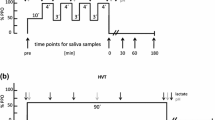Abstract
Strenuous exercise activates the hypothalamic-pituitary-adrenal (HPA) axis. Several reports showed that physical training is associated with a decreased efficiency of the feedback control of HPA axis. The aims of the present study were: 1) to evaluate the differences in the mechanical, hormonal, and lactate responses to a high-intensity isokinetic exercise among different groups of competitive athletes (CA, no.=20) of power and endurance disciplines and sedentary controls (SED, no.=10); 2) to determine the effects of the training status on the HPA axis responsiveness following exercise, as indirectly evaluated by the rates of ACTH, cortisol, and DHEA recovery after exercise. CA and SED fulfilled eight sets of twenty concentric contractions of the knee extensors at 180°/sec angular velocity throughout a constant range of motion (100°). There was a rest period of 30 sec between each set and a 3-min rest period between the two legs. Before, immediately after the isokinetic exercise and at different times in the subsequent 120 min of recovery, blood and saliva were sampled to determine plasma ACTH, salivary cortisol, serum DHEA, and serum lactate concentrations. CA showed a higher cortisol response to exercise than SED, whereas no differences were found in the responses of ACTH, DHEA and lactate. In the athlete group the exercise-induced increases of ACTH, cortisol, and lactate were higher in power athletes with respect to endurance athletes. No differences were observed between athletes and SED in the rates of hormonal recovery after exercise: this finding does not support the concept that a reduced feedback control of HPA axis can represent a feature of trained individuals.
Similar content being viewed by others
References
Few JD. Effect of exercise on the secretion and metabolism of cortisol in man. J Endocrinol 1974, 62: 341–53.
Farrell PA, Garthwaite TL, Gustafson AB. Plasma adrenocorticotropin and cortisol responses to submaximal and exhaustive exercise. J Appl Physiol 1983, 55: 1441–4.
Buono MJ, Yeager JE, Hodgdon JA. Plasma adrenocorticotropin and cortisol responses to brief high-intensity exercise in humans. J Appl Physiol 1986, 61: 1337–9.
Luger A, Deuster PA, Kyle SB, et al. Acute hypothalamic-pituitary-adrenal responses to the stress of treadmill exercise. Physiologic adaptations to physical training. N Engl J Med 1987, 21: 1309–15.
Kanaley JA, Weltman JY, Pieper KS, Weltman A, Hartman ML. Cortisol and growth hormone responses to exercise at different times of day. J Clin Endocrinol Metab 2001, 86: 2881–9.
Wittert G. The effect of exercise on the hypothalamo-pituitary-adrenal axis. In: Warren MP, Constantini NWeds. Sports endocrinology. Totowa, New Jersey: Humana Press. 2000, 43–55.
Duclos M, Minkhar M, Sarrieau A, Bonnemaison D, Manier G, Mormede P. Reversibility of endurance training-induced changes on glucocorticoid sensitivity of monocytes by an acute exercise. Clin Endocrinol (Oxf) 1999, 51: 749–56.
Duclos M, Corcuff JB, Rashedi M, Fougere V, Manier G. Trained versus untrained men: different immediate post-exercise responses of pituitary adrenal axis. A preliminary study. Eur J Appl Physiol Occup Physiol 1997, 75: 343–50.
Duclos M, Corcuff JB, Arsac L, et al. Corticotroph axis sensitivity after exercise in endurance-trained athletes. Clin Endocrinol (Oxf) 1998, 48: 493–501.
Duclos M, Corcuff JB, Pehourcq F, Tabarin A. Decreased pituitary sensitivity to glucocorticoids in endurance-trained men. Eur J Endocrinol 2001, 144: 363–8.
Bosco C, Komi PV. Mechanical characteristics and fiber composition of human leg extensor muscles. Eur J Appl Physiol Occup Physiol 1979, 41: 275–84.
Minetto M, Rainoldi A, Gazzoni M, et al. Differential responses of serum and salivary interleukin-6 to acute strenuous exercise. Eur J Appl Physiol 2005, 93: 679–86.
Kraemer WJ, Patton JF, Gordon SE, et al. Compatibility of high-intensity strength and endurance training on hormonal and skeletal muscle adaptations. J Appl Physiol 1995, 78: 976–89.
Tremblay MS, Copeland JL, Van Helder W. Effect of training status and exercise mode on endogenous steroid hormones in males. J Appl Physiol 2004, 96: 531–9.
Paccotti P, Minetto M, Terzolo M, et al. Effects of high-intensity isokinetic exercise on salivary cortisol in athletes with different training schedules: relationships to serum cortisol and lactate. Int J Sports Med 2005, 26: 747–55.
Minetto MA, Paccotti P, Borrione P, et al. Effects of the training status on the hormonal response and recovery from high-intensity isokinetic exercise: comparisons between endurance-trained athletes and sedentary subjects. J Sports Med Phys Fit 2006, 46: 494–500.
Traustadottir T, Bosch PR, Cantu T, Matt KS. Hypothalamic-pituitary-adrenal axis response and recovery from high-intensity exercise in women: effects of aging and fitness. J Clin Endocrinol Metab 2004, 89: 3248–54.
Park E, Chan O, Li Q, et al. Changes in basal hypothalamo-pituitary-adrenal activity during exercise training are centrally mediated. Am J Physiol Regul Integr Comp Physiol 2005, 289: 1360–71.
Huizenga NA, Koper JW, de Lange P, et al. Interperson variability but intraperson stability of baseline plasma cortisol concentrations, and its relation to feedback sensitivity of the hypothalamo-pituitary-adrenal axis to a low dose of dexamethasone in elderly individuals. J Clin Endocrinol Metab 1998, 83: 47–54.
Petrides JS, Mueller GP, Kalogeras KT, Chrousos GP, Gold PW, Deuster PA. Exercise-induced activation of the hypothalamic-pituitary-adrenal axis: marked differences in the sensitivity to glucocorticoid suppression. J Clin Endocrinol Metab 1994, 79: 377–83.
Oyono-Enguelle S, Gartner M, Marbach J, Heitz A, Ott C, Freund H. Comparison of arterial and venous blood lactate kinetics aftershort exercise. Int J Sports Med 1989, 10: 16–24.
Convertino VA, Keil LC, Bernauer EM, Greenleaf JE. Plasma volume, osmolality, vasopressin, and renin activity during graded exercise in man. J Appl Physiol 1981, 50: 123–8.
Flamm SD, Taki J, Moore R, Lewis SF, Keech F, Maltais F. Redistribution of regional and organ blood volume and effect on cardiac function in relation to upright exercise intensity in healthy human subjects. Circulation 1990, 81: 1550–9.
Kirschbaum C, Hellhammer DH. Salivary cortisol in psychobiological research: an overview. Neuropsychobiology 1989, 22: 150–69.
Author information
Authors and Affiliations
Corresponding author
Rights and permissions
About this article
Cite this article
Minetto, M.A., Lanfranco, F., Baldi, M. et al. Corticotroph axis sensitivity after exercise: Comparison between elite athletes and sedentary subjects. J Endocrinol Invest 30, 215–223 (2007). https://doi.org/10.1007/BF03347428
Accepted:
Published:
Issue Date:
DOI: https://doi.org/10.1007/BF03347428




